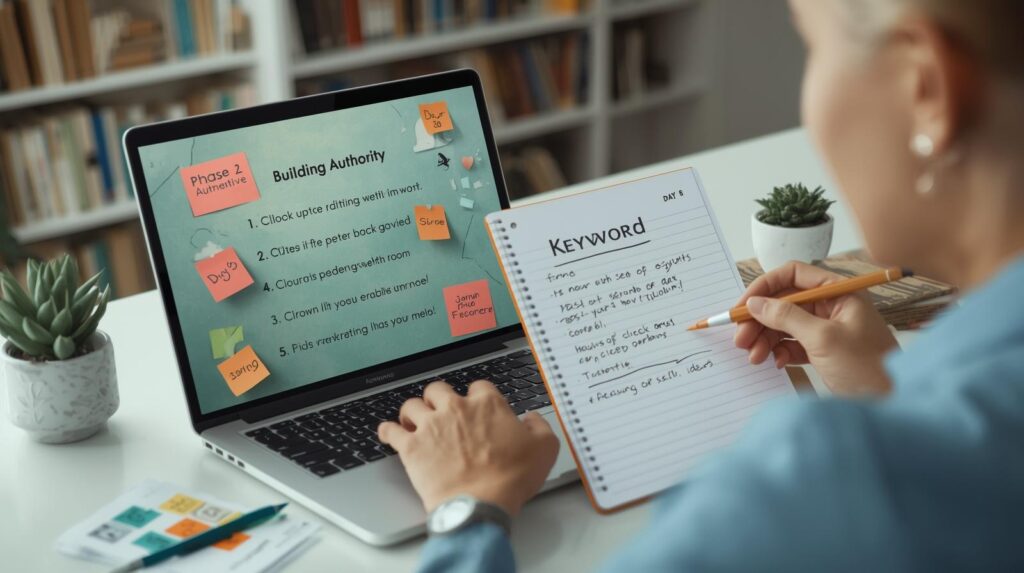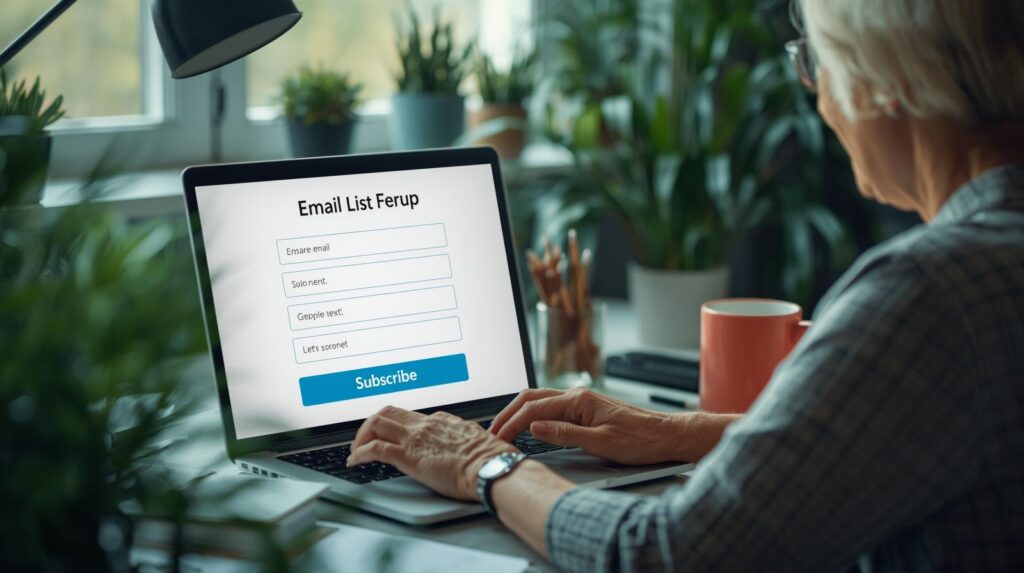When I first heard about affiliate marketing, it sounded too good to be true. The idea of earning money by simply recommending products online, with no inventory to manage or customers to deal with, felt like a fantasy.
I quickly discovered that it’s a real and powerful business model, but it’s not magic. It takes a clear plan, a bit of hard work, and the right mindset.
If you’re at the beginning of your journey and feeling overwhelmed, this guide is for you. I’ll walk you through the entire process, from the initial “what am I even doing?” We’ll break it down into four simple phases, ensuring you understand how to achieve your First Affiliate Sale and ultimately lead you to the path of your first commission.
Contents
Phase 1: The Foundation (Days 1-7)
In these early stages, focusing on strategies that lead to your First Affiliate Sale is crucial.

The first week focuses on setting yourself up for success. Just like you wouldn’t build a house without a strong foundation, the same applies to your online business.
Step 1: Understand the Basics of Affiliate Marketing
Achieving your early earnings is a milestone that validates your efforts and encourages you to keep going. This accomplishment is the first step in your journey towards successful affiliate marketing.
When someone purchases through your unique affiliate link, you receive a percentage of the sale. It’s really that simple.
Your objective is to build a foundation that supports your journey toward your First Affiliate Sale.
Understanding the journey to your initial results is crucial for beginners. Many wonder how they can replicate the success stories they’ve heard.
First, let’s define what affiliate marketing is. It’s essentially a partnership between you and a company where you promote their products or services to your audience.
Step 2: Choose Your Niche
This is often where new marketers get stuck. A niche refers to a specific, targeted group of people with a shared interest or problem.
This guide will empower you to reach your First Affiliate Sale and help you understand the steps necessary to achieve that milestone.
Here’s a simple exercise to help you find your niche:
Frequently Asked Questions
A: It depends on your effort and consistency, but with a structured 90-day plan you can realistically reach your first affiliate sale within three months.
A: Starting affiliate marketing can be done with minimal costs. You mainly need a domain, hosting, and possibly a keyword tool. Many people begin with less than $100.
A: Choose a niche that combines your interests with profit potential. A good niche solves problems for your audience, has products to promote, and isn’t too competitive.
A: Most beginners focus on SEO by publishing blog posts targeting specific keywords. Over time, you can also add social media promotion and email marketing for more traffic.
A: Yes. With patience, consistent content creation, and a focus on helping your audience, beginners can absolutely succeed. The first sale is often the hardest, but it proves the process works.
Step 2: Choose Your Niche
Choosing the right niche is crucial.
This is often where new marketers get stuck. A niche is a specific, targeted group of people with a shared interest or problem.
Here’s a simple exercise to help you find your niche:
- What are you passionate about? What topics could you talk about all day?
- What problems are you good at solving? Have you helped a friend with a specific issue?
- What are others spending money on? Do a quick search for “best [your interest] affiliate programs” to see if there are products to promote.
The sweet spot is where your passion and a profitable market intersect. Don’t worry about picking the “perfect” niche; the goal is to pick one and get started.
Your first post doesn’t need to be perfect. The key is to simply complete it. The more you write, the better you’ll get.
Achieving your First Affiliate Sale will not only validate your efforts but also inspire you to continue your journey in affiliate marketing.
Your first post doesn’t need to be a masterpiece. The most important part is to simply get it done. The more you write, the better you’ll become.
I highly recommend using WordPress, as it’s the most popular and flexible platform, and most hosting providers offer a one-click installation.
Your website doesn’t need to be fancy yet. Just focus on the basics:
- A domain name: This is your website’s address.
- Web hosting: This is where your website lives on the internet.
- A clean, mobile-friendly theme: Make sure your site looks good and works well on phones.
Step 3: Set Up Your Digital Home
Keep things simple and aim to get your site live as quickly as possible.
Now that you’ve laid a foundation, it’s time to create content that builds trust and serves your audience. In this phase, focus on providing value rather than making sales.
Based on your niche, what questions do people have? Use a free tool like Google Keyword Planner to find out what people are searching for.
Step 4: Create a Content Plan

Brainstorm at least 10 blog post ideas that solve a problem for your audience..
Step 5: Write Your First Post (And Your Next Few)
Keep your website and email list expanding.
Your first post should be an article that directly helps your audience.
When drafting your content, remember that your ultimate goal is to guide your readers toward taking action that leads to your initial results and your first commission.
Focus on quality over quantity. An in-depth, well-researched article is worth ten times more than short, poorly written ones.
Now that you have some content, it’s time to seek out products to recommend. Start with large networks like Amazon Associates or look for specific programs in your niche by searching for “[your niche] + affiliate program.” Choose products you genuinely believe in and would personally use.
- Solve a specific problem.
- Use headings and bullet points to make the content easy to read.
- Write in a conversational tone—as if you’re talking to a friend.
- Don’t worry about affiliate links just yet. The goal is to build authority.
Many people ask where to find the right training and tools. For beginners, having everything in one place can be very beneficial. I recommend a platform like Wealthy Affiliate. They offer comprehensive training, web hosting, and a keyword research tool all in one location, simplifying the process of building your business without getting bogged down by technical details. If you want a community and a step-by-step roadmap, check them out here. Just a heads-up, this is my affiliate link, so I may earn a commission if you decide to join at no extra cost to you.
Your first post doesn’t need to be a masterpiece. The most important part is to simply get it done. The more you write, the better you’ll become.
Phase 2: Build Momentum (Days 8–30)
Now that you’ve set the foundation in Phase 1, it’s time to build momentum. This 3-week stretch is all about adding content, attracting your first visitors, and getting ready for monetization. By the end of Day 30, you’ll have a stronger website, an audience beginning to form, and the groundwork laid for affiliate income.

Week 2 (Days 8–14): Expand Core Content & Keyword Research
What to focus on this week:
- Add more high-value content to your site.
- Find the questions your audience is really asking.
- Strengthen your site structure.
Action steps:
- Do keyword research: Use tools like Google’s Keyword Planner or Ubersuggest to find low-competition, long-tail keywords in your niche. Focus on informational queries (“how to,” “tips for,” “best way to…”).
- Publish 3–5 posts: Create helpful, problem-solving articles that directly address your audience’s struggles.
- Link internally: Connect new posts to your earlier content so readers (and Google) can navigate easily.
- Optimize your posts: Make sure each article has a clear title, strong meta description, headings, and images with alt text.
- Set up analytics: Install Google Analytics and Search Console so you can start tracking what’s working.
Week 3 (Days 15–21): Audience Engagement & Outreach
What to focus on this week:
- Start getting your content in front of people.
- Invite interaction and feedback.
- Begin connecting with others in your niche.
Action steps:
- Promote your posts: Share your articles in relevant Facebook groups, forums, or Pinterest boards. Don’t just drop links — add value, start conversations, and be helpful.
- Encourage comments: Ask questions at the end of each blog post. Reply to every comment you receive — this builds trust and keeps readers engaged.
- Outreach: Find 3–5 bloggers or creators in your niche. Comment on their work, share their content, and start building relationships.
- Plan: Draft your next 10–15 blog post ideas so you always know what to write next.
Week 4 (Days 22–30): Validation & Prepping for Monetization
What to focus on this week:
- Review your early results.
- Polish and improve what you’ve published.
- Prepare to introduce affiliate links in Phase 3.
Action steps:
- Audit your posts: Which articles are getting the most views or engagement? Update them with more depth, add images, and improve internal linking.
- Begin soft monetization: Add one or two subtle affiliate mentions where it fits naturally (always keep value first).
- Apply to affiliate programs: Choose 3–5 affiliate programs/products that truly help your audience. Gather your affiliate links and resources.
- Start list-building prep: Draft a simple lead magnet (like a checklist or resource guide) and set up an email tool (Mailchimp, ConvertKit, etc.). Even if you don’t launch it yet, get the system ready.
- Review progress: By Day 30, check your analytics: how many posts are live, what traffic you’ve received, and what engagement you’re seeing. Celebrate small wins — they’re signs of momentum!
Ongoing Daily/Weekly Habits (Days 8–30)
- Publish at least 2–4 posts per week.
- Spend a few minutes daily in your niche community (forums, groups, or social media).
- Track your traffic and adjust your content plan.
- Keep learning — read competitor blogs, listen to podcasts, and notice what works for others.
- Stay consistent: progress is built brick by brick.
👉 By the end of Phase 2, you should have at least 10+ quality posts on your site, early traffic trickling in, and affiliate programs ready to promote in Phase 3.
Phase 3: The Monetization Switch (Days 31-60)
This type of content can be where the magic happens. A detailed product review or a listicle such as “The 10 Best Tools for Affiliate Marketing” is a great way to introduce affiliate links.
With your content foundation established, you can start adding affiliate links and setting up systems that will generate income.
And keep your website and email list growing.
As you explore affiliate programs, prioritize those that align with your niche for a greater chance of making your First Sale. Choosing the right programs will greatly enhance the probability of your success.
Your job is to stay consistent. Keep creating valuable content, keep building trust.
When drafting your content, always keep in mind that ultimately, your goal is to guide your readers towards taking action that leads to your initial results.
Step 6: Join Affiliate Programs
Now that you have some content, it’s time to find products to recommend. You can start with large networks like Amazon Associates or find specific programs in your niche by searching for “[your niche] + affiliate program.” Look for products you genuinely believe in and would use yourself.
Each time you write, you’re one step closer to your monetization milestone. Embrace the process and don’t rush; Affiliate Sale will come as a result of consistent effort.
A lot of people ask me where to get the right training and tools to do this. For a beginner, it can be really helpful to have everything in one place. That’s why I recommend a platform like Wealthy Affiliate. They provide comprehensive training, web hosting, and a keyword research tool all under one roof.
Your email list will play a vital role in guiding your audience towards their monetization milestone.
It’s a great way to simplify the process and focus on the important parts of building your business without getting bogged down by technical details. If you’re looking for a community and a step-by-step roadmap to follow, you can check them out here. Just a heads-up, this is my affiliate link, so I may earn a commission if you decide to join at no extra cost to you.

Step 7: Write Your First “Review” or “Best of” Post
This type of content is often where the magic happens. A detailed product review or a listicle like “The 10 Best Tools for Affiliate Marketing” is a fantastic way to introduce affiliate links.
Step 8: Set Up Your Email List
As you explore affiliate programs, prioritize those that align with your niche for a higher chance of making your first commission. Partnering with the right programs will lead to your First Affiliate Sale.
Products that resonate with your audience are much more likely to contribute to your first commission.
Selecting products that resonate with your audience will significantly contribute to your Affiliate Sales.
It’s vital to remain consistent in creating valuable content, building trust, and growing your website and email list.
This is the most crucial step for long-term success. Your email list is a direct line to your most engaged audience. Use a service like ConvertKit or Mailchimp to create a simple sign-up form on your website. Offer a free resource in exchange for their email—such as a guide, checklist, or short course. This converts casual visitors into loyal followers.

Phase 4: The Path to Your First Sale (Days 61-90)
Each review you create will not only inform your audience but also pave the way to your First Sale. Authenticity in your reviews is vital for building trust and securing your first commission.
You’ve built your foundation and added monetization. Now it’s time to focus on driving traffic and getting that first commission.
Each moment you dedicate to nurturing your content is a step towards your First Sale. Patience and consistency are essential for achieving your Sales.
Consistently engage them with valuable content about achieving their early earnings.
Engage them consistently with valuable content related to achieving their First Affiliate Sale.
Remember, your content won’t be discovered by chance. Start by focusing on one or two traffic sources.

- SEO: Continue writing high-quality content that answers specific questions your audience is asking. Over time, Google will recognize you as an authority, and your content will start to rank.
- Social Media: Share your blog posts on platforms where your audience spends time. For a niche like “healthy living for seniors,” Pinterest and Facebook might be great choices.
- Email: Send an email to your small but growing list whenever you publish a new article.
Step 9: Patience and Consistency
Your email list will be instrumental in guiding your audience towards their early earnings. Engage them consistently.
This final step is crucial. Your initial results might not occur within the first week or even the first month. Stay consistent.
Driving traffic is essential for achieving your sales. Without visitors, there won’t be opportunities for your First Affiliate Sale.
Your job is to stay consistent. Keep creating valuable content, keep building trust, and keep your website and email list growing.
Driving traffic is crucial for your initial results. Without visitors, there won’t be opportunities for your first commission
Final Thoughts
This guide provides a solid plan for your first 90 days. It may seem daunting, but by focusing on one step at a time, you can easily turn this vision into reality.
Each moment spent nurturing your content is a step towards your Sale. Remember that patience and consistency are crucial in reaching your first commission.
That notification of your First Affiliate Sale will mark a significant turning point in your journey. Celebrate it as a milestone marking the start of your success.
Embrace the journey towards your first commission. Every step you take is a building block for long-term success.
Every moment dedicated to nurturing your content is a step towards your Affiliate Sales.
Every review you create will not only inform your audience but also pave the way to your initial results.
Focusing on strategies that lead to your early earnings is essential for long-term success.
Every moment dedicated to nurturing your content is a step towards your monetization milestone.
Driving traffic is crucial for your initial results and ultimately for securing your First Affiliate Sale.
Your email list will play a vital role in guiding your audience towards their earnings.
